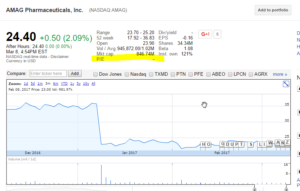One of the things I love about the strategy detailed in The Little Book that Beats the Market is that the stocks to buy are chosen based on a specific formula, and Joel Greenblatt, the book’s author, has already put together a free site that identifies these stocks for you so you don’t even have to run the formula! You get your portfolio designed for you automatically. What could be easier?
Not so Fast
This post is one of several I’m planning to write that points out some potential gotchas in the Formula Investing strategy. One of the things I’ve learned recently is that, even though you believe in the strategy and in the integrity of Mr. Greenblatt’s site, you should not just blindly buy the stocks that appear on the MagicFormulaInvesting.com website. There are various reasons for this but the one I’m bringing up today deals with the fact that there seems to be a substantial delay between the time a company’s financial data are released to the public and the time the data affect the MagicFormulaInvesting rankings. The site’s picks are updated for current stock prices daily, but companies’ financial data are only released quarterly and I believe the folks who work on the site (whoever they are) have to do a fair amount of work to ensure they’re comparing apples to apples. I will update this post as I find out more information on how MagicFormulaInvesting.com is updated, but consider the following scenario.
One of the 30 stocks I purchased is AMAG Pharmaceuticals, Inc. (AMAG). I bought the stock on 1/31/2017 just a few weeks after the price dropped substantially due to the latest financial reports. At the time the stock appeared on MagicFormulaInvesting.com. On the surface this seems fine. The service is supposed to identify value stocks. What I either didn’t notice or didn’t care about was that AMAG’s P/E ratio appeared on Google Finance and Yahoo Finance as a “-“because the company is not profitable.

It makes sense to invest in companies that have a low P/E ratio, but not so much sense to invest in companies that are losing money. If you look at the “Most Recent Quarter Data” column for the stock screener on MagicFormulaInvesting.com (this is the last column) you’ll notice that sometimes the site does not seem to be using the latest data. I know from reading The Book that the Magic Formula does some tweaking with a company’s number to arrive at its choices, and Magic Formula Investing states in its FAQ page “We then make some slight accounting adjustments to these commonly used ratios in order to be more accurate for comparison purposes across various companies.”
Also from the Magic Formula Investing FAQ page:
Q: How often is the data updated?
A: Typically the price data is updated every trading day at approximately 8:00 AM. The financial data is updated quarterly when we receive the information from our data provider.
The data provider? I think that’s just the NYSE or, in this case, NASDAQ. So they make it sound like their picks are up to date with the latest information but since I bought AMAG the stock has dropped off the site’s screener. Syntel, Inc (SYNT) was another example of a Magic Formula stock with a “-” P/E ratio when looked up on Yahoo Finance or Google Finance – there are many examples. It makes sense to invest in companies that have a low P/E ratio, but not so much sense to invest in companies that are losing money. I’m going to do more investigation on this but, unless I can understand the discrepancy, I’ll be hesitant to invest in these MF stocks going forward. For this and other reasons which I’ll discuss in later posts, I always do a sanity check on Google or Yahoo Finance before investing in a company that appears on Magic Formula Investing.
Dear Andrew,
Did you ever find out the issue of magicformula stocks seeming to have no P/E ratio on yahoo finance etc…? I noticed this also many times, but hoped/thought this had to do with the adjustments in (smart) calculations that the MFI site Made.
Hope to hear from you, good luck!
Wouter Haenen
Hello again Wouter,
No, I never found out about why the MF screener, which I would think would only identify profitable companies, includes companies that have no P/E ratio. This is one of my biggest concerns with the MFI screener. I think there are three possible explanations. The first one is: the screener is not using the latest data. If you look at the date of the screener’s “Most Recent Quarter Data” column, sometimes it looks like they’re not yet using the latest data; perhaps it takes them time to process it (?). I suspect that some of the companies on the screener were previously profitable but now are not. The 2nd explanation is: there are bad problems with the screener besides outdated data and it shouldn’t be trusted at all, and the third explanation is the one you were hoping for. Since the screener is not responsive to user questions, I really don’t know and haven’t had time to delve into this, but please let me know if you find any evidence. My strategy, though I haven’t been totally consistent, is to avoid picking stocks that have no P/E ratio, and just choose another one.